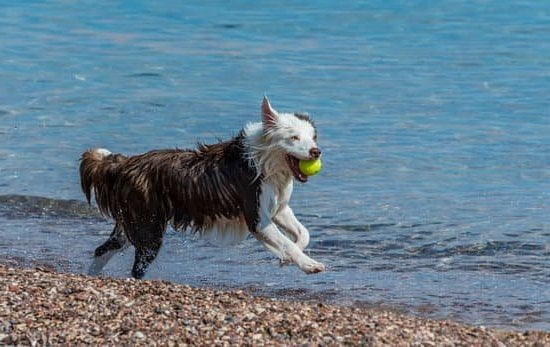Training your dog to be protective can be a rewarding and beneficial experience for both you and your furry companion. Whether you are looking for a loyal guard dog or simply want to enhance your dog’s innate protective instincts, it is essential to start by building trust and loyalty.
Dogs are naturally pack animals, and they instinctively look up to their leaders for guidance and protection. By establishing yourself as a reliable leader, you create a foundation of trust that will make the training process more effective. This involves consistent positive reinforcement, clear communication, and setting boundaries for your dog.
It is crucial to develop a strong bond with your dog before embarking on protective training. Spending quality time together through activities such as playtime, exercise, and obedience training will deepen the connection between you and your furry friend. Building this bond not only fosters mutual trust but also encourages your dog’s willingness to protect you when necessary.
In addition to trust, loyalty plays a significant role in training your dog to be protective. Dogs are naturally loyal creatures who strive to protect their loved ones. However, it is vital that this loyalty is based on positive reinforcement rather than fear or aggression. By creating an environment of love, respect, and reward-based training methods, you can foster a deep sense of loyalty in your canine companion.
In the following sections of this article, we will delve into the psychology behind protective behavior in dogs, choosing the right breed for protection training, establishing leadership and setting boundaries effectively. Additionally, we will explore socialization techniques for controlled protective behavior and foundational obedience training as well as various techniques for teaching guarding and alert behaviors.
Stay tuned to learn how to teach an appropriate protective response while avoiding aggression and handling unwanted protective behaviors tactfully. Finally, we will discuss how becoming a responsible owner adds accountability in raising a protective dog. So let’s begin the journey of training your dog to be protective by building a foundation of trust and loyalty together.
Understanding the Psychology Behind Protective Behavior
Dogs have a natural instinct to protect their families and territories. Understanding the psychology behind protective behavior is crucial when training a dog to be protective. By delving into the inner workings of a dog’s mind, owners can effectively harness their dog’s instincts and develop a well-rounded protector.
1. Understanding Canine Instincts:
Protective behavior in dogs stems from their ancestral roots as pack animals. Dogs have an innate drive to safeguard what they perceive as their pack, which includes their human family members and their home environment. This instinct is further heightened in certain breeds that were selectively bred for protection and guarding purposes.
2. Importance of Trust and Confidence:
To cultivate protective behavior in dogs, it is essential to build trust and foster confidence. Dogs must feel secure within the family unit and have faith in their owners as reliable leaders. Establishing this foundation of trust requires consistent communication, fair boundaries, positive reinforcement, and clear leadership.
3. The Role of Socialization:
Socialization plays a vital role in shaping a dog’s protective behavior. By exposing them to various people, animals, environments, and situations early on, dogs learn to differentiate between real threats and harmless stimuli. This exposure helps them develop self-control while remaining vigilant when encountering potential dangers.
Training a dog to be protective involves tapping into their innate instincts while maintaining control over aggressive tendencies. With proper understanding of canine psychology combined with training techniques aimed at building trust and socialization skills, responsible owners can mold their dogs into well-balanced protectors who are both loyal guardians and trusted companions.
Choosing the Right Dog Breed for Protective Training
When it comes to training a dog to be protective, one important aspect to consider is the breed of the dog. Not all dogs are equally suited for this type of training, as some breeds have natural instincts that make them more inclined to be protective. It is crucial to choose a dog breed that has the right temperament, characteristics, and physical abilities for protective training.
Firstly, it is essential to understand that not all breeds are suitable for becoming protective dogs. Breeds like German Shepherds, Rottweilers, Doberman Pinschers, and Belgian Malinois are known for their protective instinct and are commonly used in roles such as police or military work. These breeds have been selectively bred through generations to possess qualities like loyalty, courage, and protectiveness.
Additionally, each breed has unique traits and qualities when it comes to protection. For example, German Shepherds are intelligent and versatile dogs that excel in obedience training and can quickly understand complex commands. On the other hand, Rottweilers are known for their strength and fearlessness. Doberman Pinschers are highly intelligent with a strong drive to protect their families.
Choosing the right breed also involves considering factors such as the owner’s lifestyle and living situation. Some breeds may require more space or exercise than others. It is crucial to thoroughly research different breeds and consult with professionals or experienced trainers before making a decision.
| Breed | Temperament | Physical Characteristics |
|---|---|---|
| German Shepherd | Loyal, Courageous, Intelligent | Medium-sized; Strong build |
| Rottweiler | Fearless, Calm, Confident | Large-sized; Muscular |
| Doberman Pinscher | Loyal, Energetic, Protective | Medium to large-sized; Sleek build |
Establishing Leadership and Setting Boundaries
One of the most important aspects of training a dog to be protective is establishing yourself as the pack leader. Dogs are natural pack animals and instinctively look for a strong leader to follow. By taking on this role, you are showing your dog that you are in charge and that they can trust you to make decisions on their behalf. Here are some techniques to help establish leadership with your dog:
- Consistency: Dogs thrive on routine and consistency. Establish a set schedule for feeding, exercise, and training sessions. Stick to these routines as much as possible to provide a sense of stability for your dog.
- Clear Communication: Use clear commands and signals when interacting with your dog. Avoid confusing or contradictory cues, as this can lead to frustration and uncertainty in your dog’s mind.
- Set Rules and Boundaries: Dogs need boundaries to feel secure. Decide what behaviors are acceptable and unacceptable, and enforce them consistently. For example, do not allow your dog on the furniture if you don’t want them there.
- Reward Good Behavior: Positive reinforcement is key in establishing leadership. When your dog follows commands or exhibits good behavior, reward them with praise, treats, or playtime. This helps reinforce the idea that following your lead is rewarding.
- Be Confident: Dogs can sense our emotions, so it’s important to remain calm and confident around them. Projecting confidence helps show your dog that you are capable of handling any situation that may arise.
By establishing yourself as a strong leader through consistent routines, clear communication, setting boundaries, rewarding good behavior, and projecting confidence, you will lay the foundation for successful protective training with your dog.
Socializing Your Dog for Controlled Protective Behavior
Socialization plays a crucial role in training a dog to have controlled protective behavior. It is essential to expose your dog to various people, animals, and environments from an early age to ensure they develop the necessary social skills and understand what is considered normal behavior. This section will provide valuable insights into the importance of socialization and how to implement it effectively.
The Importance of Early Socialization
Early socialization is key to shaping your dog’s behavior and ensuring they can distinguish between normal situations and actual threats. By introducing your dog to different people, including strangers, children, and those wearing hats or glasses, you are helping them become comfortable in various human interactions. Additionally, exposing your dog to other pets and animals will assist them in learning appropriate responses and reduce aggression towards unfamiliar animals.
Gradual Exposure to Different Environments
Introducing your dog to different environments is equally important for their development. Take your dog on regular walks around busy streets, parks, or public places where they can encounter various sounds, smells, and sights. Gradually increase the level of exposure by taking them to events with crowds or inviting guests over to your home. This gradual approach ensures that your dog learns how to respond appropriately without becoming overwhelmed or reactive.
Positive Reinforcement During Socialization
During the socialization process, it is vital to use positive reinforcement techniques such as treats, praise, or playtime when your dog behaves appropriately around new people and in new environments. This positive association will reinforce their understanding of what is expected from them in different situations. Avoid punishment-based training methods as they can lead to fear or anxiety in your dog.
By focusing on early socialization with structured exposure to various stimuli in a positive manner, you can help your dog develop controlled protective behavior. The next section will discuss basic obedience training as a foundation for protection, building upon the socialization process.
Basic Obedience Training as a Foundation for Protection
Basic obedience training is a crucial foundation for training a dog to be protective. By establishing obedience skills, you can ensure that your dog listens and responds to your commands effectively, which is essential for their safety and the safety of those around them. Here are some training techniques and tips to help lay the groundwork for protection training:
1. Teaching basic commands: Start with teaching fundamental commands such as “sit,” “stay,” “down,” and “come.” These commands will create a strong bond between you and your dog, while also giving you control over their actions. Utilize positive reinforcement methods, such as treats or praise, to motivate your dog during training sessions.
2. Consistency: Consistency is key when it comes to obedience training. Use the same verbal cues and hand signals consistently so that your dog can easily understand what is expected of them. Set aside regular practice sessions each day to reinforce their training.
3. Leash Training: Leash training is an important aspect of obedience training, as it teaches your dog proper leash manners and helps establish boundaries. Begin by introducing your dog to the leash gradually, allowing them time to get used to it. Encourage loose leash walking by rewarding good behavior with treats or praise.
4. Proofing: Once your dog has mastered basic obedience commands in a controlled environment, it’s important to proof their skills in different situations and environments. Gradually introduce distractions such as noise or other animals while practicing commands so that your dog becomes accustomed to obeying despite distractions.
By laying a solid foundation of basic obedience training, you are setting the stage for more advanced protection training down the line. It builds trust, establishes clear communication between you and your dog, and ensures that they have the necessary skills to fulfill their protective role effectively while maintaining good behavior and temperament.
Remember that obedience training takes time and patience. Practice regular training sessions with positive reinforcement techniques, and always prioritize your dog’s safety and well-being throughout the process. With dedication and consistent training, you’ll be on your way to raising a responsible and protective dog.
Training Techniques for Teaching Guarding and Alert Behaviors
Once you have established a strong foundation of trust and leadership with your dog, you can begin training them to exhibit guarding and alert behaviors. These behaviors are important for a protective dog as they serve as early warning signs of potential threats and can deter intruders. However, it is essential to approach this training with caution to avoid encouraging aggressive behavior or fear-based reactions.
One effective technique for teaching guarding behavior is using positive reinforcement. Start by teaching your dog the “guard” command, which signals them to stay in a specific location or area and keep watch. Use treats or toys as rewards when they successfully stay in place and remain attentive. Gradually increase the duration of their guarding behavior while making sure to reward them intermittently.
Another useful technique is desensitization and counterconditioning. This involves exposing your dog to different stimuli that may trigger alert behavior, such as doorbells or strangers approaching the house, in a controlled environment. Start by introducing these stimuli at a distance where your dog remains calm, and reward them for their calm behavior. Gradually decrease the distance over time while rewarding their relaxed responses. This helps them associate these stimuli with positive experiences rather than perceiving them as threats.
It is also crucial to teach your dog an “alert” command, which signals them to bark or show other signs of alertness when they sense a potential threat. Begin by pairing the verbal command with a visual cue, such as pointing at an object or person that requires attention. Reward your dog when they respond appropriately to the command with barking or displaying alert behavior.
Using these training techniques, you can effectively teach your dog guarding and alert behaviors while maintaining a balanced temperament without encouraging aggression. Remember that consistency, patience, and proper supervision during training are key elements in shaping desirable protective behaviors in your canine companion.
| Technique | Description |
|---|---|
| Positive Reinforcement | Rewarding the dog for staying in place and remaining attentive while guarding. |
| Desensitization and Counterconditioning | Exposing the dog to stimuli that may trigger alert behavior in a controlled environment and rewarding calm responses. |
| Alert Command Training | Teaching the dog to respond to a verbal command with barking or displaying signs of alertness. |
Teaching Appropriate Protective Response
Teaching a dog to have a protective response is an important aspect of training, but it is equally important to teach them to differentiate between real threats and harmless situations. This not only ensures the safety of both the dog and their owner but also prevents any unnecessary aggression or fear. In this section, we will explore techniques that can be used to teach dogs to discern between potential dangers and non-threatening situations.
Introducing Controlled Scenarios
One effective method in teaching dogs to differentiate threats is by exposing them to controlled scenarios. Start by gradually introducing your dog to various stimuli, such as different sounds, unfamiliar objects, or individuals entering your property. These scenarios should be manageable and safe for both you and your dog. Begin with low-intensity situations where there is no actual threat present.
Positive Reinforcement Training
Using positive reinforcement techniques during these controlled scenarios can help train your dog on appropriate responses. Reward your dog whenever they display calm behavior in the presence of a non-threatening stimulus. Use treats, praise, or toys as rewards to create a positive association with the situation. By consistently reinforcing calm behavior, your dog will associate appropriate responses with positive outcomes.
Gradual Exposure to Realistic Situations
Once your dog has demonstrated an understanding of appropriate responses in controlled scenarios, it’s time to gradually expose them to more realistic situations that may mimic potential threats. This could include encountering people wearing hats or sunglasses or encountering strangers approaching in a more assertive manner. The key is not only exposing them but ensuring that they still maintain their calm behavior despite the increased pressure.
Professional Assistance
If you find that teaching your dog to differentiate threats on your own proves challenging, seeking professional assistance from a qualified dog trainer may be beneficial. A professional trainer can provide guidance on how best to approach this aspect of training and tailor their methods specifically to your dog’s needs.
Teaching a dog to differentiate threats is crucial in ensuring they possess appropriate protective responses. By gradually introducing controlled scenarios, utilizing positive reinforcement techniques, and exposing them to more realistic situations over time, you can help your dog develop the necessary skills to distinguish between potential dangers and harmless situations.
Avoiding Aggression
It is essential to strike a balance between a dog’s protective instincts and maintaining a good temperament. By doing so, you can ensure that your dog remains both protective and well-behaved.
The Role of Socialization
Socialization plays a critical role in avoiding aggression and maintaining a balanced temperament in your dog. Expose your dog to various environments, people, and animals from an early age. This exposure will help your dog become comfortable with different situations and reduce the likelihood of aggression towards strangers or unfamiliar stimuli. In addition to providing positive social experiences, it is essential to teach your dog appropriate behavior when encountering new people or animals.
Consistent Training Methods
Consistency is key when training a protective dog with good temperament. Use positive reinforcement techniques to reward desired behaviors such as remaining calm in the presence of strangers. Avoid using punishment-based methods as they can lead to fear or aggression in your dog.
Set clear boundaries and rules for your dog’s behavior, both at home and outside. Teach basic commands such as “sit,” “stay,” and “leave it” to establish control over their actions. Consistent training builds trust between you and your dog while reinforcing their understanding of acceptable behavior.
Monitoring Stress Levels
Pay attention to signs of stress or anxiety in your protective dog, as these can potentially trigger aggressive responses. Some common signs include excessive barking, growling, pacing, panting heavily, or displaying stiff body language.
Address any sources of stress promptly by removing them from the situation or implementing counter-conditioning methods. Counter-conditioning involves associating the trigger with positive experiences through gradual exposure, helping your dog develop more positive associations over time.
By focusing on socialization, consistent training methods, and monitoring stress levels, you can successfully avoid aggression while nurturing a well-rounded protective companion. Striving for this balance will ensure that your dog is both reliable in protecting you and your property while maintaining a friendly and sociable disposition.
Handling Unwanted Protective Behaviors
Unwanted protective behaviors in dogs can be challenging to handle, but with patience and consistency, they can be corrected and redirected. It is important to understand that these behaviors may stem from a dog’s instincts to protect its family or territory. However, it is crucial to teach them the appropriate responses and establish clear boundaries. This section will discuss effective techniques for handling unwanted protective behaviors in dogs.
One method for addressing unwanted protective behaviors is through desensitization and counter-conditioning. This approach involves gradually exposing the dog to stimuli that typically trigger the unwanted behavior, while also providing positive experiences and rewards. For example, if a dog barks excessively at visitors approaching the house, you can start by having a friend stand at a distance where the dog doesn’t react aggressively.
Then, reward your dog with treats and praise for remaining calm. Gradually decrease the distance over time until your dog no longer reacts negatively.
Redirecting your dog’s energy towards more appropriate behaviors is another strategy for handling protective behavior issues. Engaging your dog in activities such as fetch or obedience training redirects their focus away from potential triggers of protective behavior. It is essential to ensure that your dog gets regular physical exercise and mental stimulation to alleviate pent-up energy that may contribute to aggressive tendencies.
In some cases, seeking professional help from a certified dog trainer or animal behaviorist may be necessary if you’re finding it challenging to handle your dog’s unwanted protective behaviors on your own. These professionals can provide expert guidance tailored to your specific situation and assist you in developing an effective training plan.
To summarize, correcting and redirecting unwanted protective behaviors requires consistent training methods like desensitization, counter-conditioning, redirection, and seeking professional help if needed. By implementing these strategies consistently over time, it is possible to modify your dog’s behavior and ensure a safe and harmonious living environment for both you and your pet.
| Training Technique | Description |
|---|---|
| Desensitization and Counter-Conditioning | This method involves gradually exposing the dog to stimuli that trigger unwanted behavior while providing positive experiences and rewards. |
| Redirection | Engaging the dog in activities like fetch or obedience training to redirect their focus away from potential triggers of protective behavior. |
| Professional Help | Seeking assistance from a certified dog trainer or animal behaviorist who can provide expert guidance tailored to your specific situation. |
Conclusion
In conclusion, training a dog to be protective requires patience, consistency, and a deep understanding of your dog’s psychology. Building trust and loyalty with your dog is crucial in order to establish a strong foundation for protective training. By showing your dog that you are a reliable leader who will protect them, you can earn their trust and encourage them to develop their protective instincts in a controlled manner.
Choosing the right breed for protective training is also essential. Not all dogs have the natural instincts or temperament needed to excel in this type of training. Researching different breeds and understanding their specific traits will help you select a dog that is well-suited for protection work.
Throughout the training process, it is important to establish strong leadership and set clear boundaries for your dog. Consistent discipline and positive reinforcement will help shape your dog’s behavior and reinforce the idea that only certain behaviors are acceptable when it comes to protection.
Socializing your dog is another key component of responsible protection training. Exposing your dog to various environments, people, and animals from an early age will help them understand what situations warrant a protective response and what situations do not.
Lastly, it is vital to strike a balance between harnessing your dog’s natural protective instincts and maintaining good temperament. Encouraging aggression or overly aggressive behavior should always be avoided. Instead, focus on teaching appropriate protective responses that are rooted in obedience and control.
By following these guidelines and approaches outlined in this article series, you can become a responsible owner of a protective dog. Training them effectively will not only ensure the safety of yourself and others but also contribute to the overall well-being of your loyal companion.
Frequently Asked Questions
Can I train my dog to be a protection dog?
Training a dog to be a protection dog is possible, but it requires expertise, patience, and dedication. It’s essential to understand that not every dog is suitable for protection work. Breeds with natural protective instincts such as German Shepherds, Rottweilers, and Belgian Malinois are often selected for this specialized training.
The process typically involves obedience training to establish a strong foundation for the dog and then progressing to more advanced exercises such as controlled aggression and defensive guarding. Professional trainers who specialize in protection dog training can guide you through the necessary steps to develop your dog’s skills while ensuring their safety and well-being.
How do you train a dog to guard and protect?
Training a dog to guard and protect requires a systematic approach built on trust, obedience, socialization, and controlled behavior. Begin by focusing on basic obedience commands like “sit,” “stay,” and recall exercises so that your dog understands proper behavior expectations. Socialization is crucial as it exposes your dog to various people, situations, and environments from an early age, resulting in an adaptable and confident companion.
Next, you can introduce controlled scenarios where your dog learns to alert or bark when they sense a potential threat while remaining calm under your guidance. A consistent reinforcement of appropriate guarding behaviors paired with positive reinforcement techniques will further shape their ability to protect you or your property.
How do I train my dog to be aggressive towards strangers?
It’s important to note that training a dog to be aggressive towards strangers is generally not recommended or encouraged for several reasons. Aggression should always be the last resort when it comes to protecting oneself or one’s property. Instead of teaching aggression towards strangers in particular, focus on building a well-socialized and obedient companion who displays confidence when introduced to new people or situations.
Early puppyhood socialization classes can play a significant role in familiarizing your pet with different individuals while promoting positive interactions instead of fear or hostility. Training should prioritize positive reinforcement techniques that reward desired behaviors rather than encouraging aggression towards any specific group of people. Remember, responsible dog ownership means ensuring both the safety of others and the well-being of your furry friend.

Welcome to the blog! I am a professional dog trainer and have been working with dogs for many years. In this blog, I will be discussing various topics related to dog training, including tips, tricks, and advice. I hope you find this information helpful and informative. Thanks for reading!





